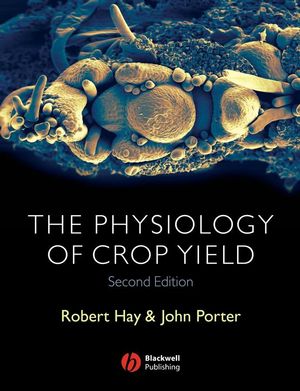The Physiology of Crop Yield, 2nd EditionISBN: 978-1-4051-0859-1
Paperback
336 pages
November 2006, Wiley-Blackwell
 This is a Print-on-Demand title. It will be printed specifically to fill your order. Please allow an additional 10-15 days delivery time. The book is not returnable.
|
||||||
Preface.
Acknowledgements.
1. Introduction.
2. Development and Phenology. How Crops Fit Their Environment: Concepts and Case Histories.
2.1 Crop Development: Concepts and Tools.
2.1.1 Growth Stages and Phasic Development.
2.1.2 Events at the Stem Apex: The Leek as a Simple Model Species.
2.1.3 Events at Stem Apices: Branching and Reproductive Development in Wheat.
2.1.4 Events at Stem Apices: The Consequences of Separation of Male and Female Organs in Maize.
2.1.5 Phenology Determined by Events at Axillary Meristems: Determinate and Indeterminate Soybean Varieties.
2.1.6 Components of Yield.
2.2 Case Histories: The Influence of Environment and Management on Crop Development and Phenology.
2.2.1 Convergence and Synchrony: The Influence of Sowing Date on Winter Wheat in Northern Europe.
2.2.2 Crop Improvement and the Anthesis-Silking Interval in maize.
2.2.3 Adaptation of Soybean to Different Latitudes: Phasic Analysis of the Photoperiodic Control of Flowering.
2.2.4 Development in Storage: Physiological Age and Tuber Initiation in the Potato.
2.2.5 Complementary Phenologies and Plant Habits in Mixed Cropping: Temperate Grass/Clover Swards.
3. Interception of Solar Radiation by the Canopy.
3.1 The Life History of a Leaf.
3.2 The Components of Plant Leaf Area Expansion.
3.2.1 Crop Emergence.
3.2.2 Leaf Production.
3.2.3 Leaf Expansion.
3.2.4 Branching.
3.2.5 Senescence, Removal and Damage: Leaf Life Span.
3.3 The Development of the Crop Canopy: Leaf Area Index.
3.3.1 Seasonal Development of Leaf Area Index.
3.3.2 Leaf Area Index and Crop Management.
3.4 Canopy Architecture and the Interception of Solar Radiation.
3.4.1 Seasonal Patterns of Interception.
3.4.2 Optimum and Critical Leaf Area Indices.
3.4.3 Leaf Photosynthesis and Canopy Properties.
3.4.4 Canopy Extinction Coefficient.
4. Photosynthesis and Photorespiration.
4.1 Introduction.
4.2 Photosynthetic Efficiency.
4.3 Photosynthetic Processes.
4.3.1 Photosynthesis as a Cellular Biochemical Process.
4.3.2 Photosynthesis as a Leaf Diffusive Process.
4.3.3 Photosynthesis as a Crop Canopy Process.
4.4 The C4 Photosynthesis Mechanism.
4.5 Water Shortage and Photosynthesis.
4.6 Nitrogen Effects on Photosynthesis.
4.7 Ozone Effects on Photosynthesis and Crop Productivity.
5. The Loss of CO2: Respiration.
5.1 Introduction.
5.2 The Basis of Crop Respiration.
5.3 Growth and Maintenance Respiration.
5.4 The Respiration of Different Plant Substrates.
5.5 Growth and Maintenance Respiration in the Field.
5.6 Respiration Associated with Crop Processes.
5.7 Environmental Effects on Respiration.
5.8 Crop Respiration in the Future.
6. The Partitioning of Dry Matter to Harvested Organs.
6.1 The Processes and Pathways of Assimilate Partitioning.
6.2 Ontogeny and Assimilate Partitioning: A Survey of Source/Sink Relationships.
6.3 Time Courses of Dry Matter Partitioning: Harvest Index.
6.4 Limitation of Yield by Source or Sink.
6.5 Sink Limitation of Yield in Cereals – Physiology of Ineffective Grain Setting.
6.6 Assimilate Partitioning and Crop Improvement: Historic Trends in Harvest Index of Wheat and Barley.
6.7 Assimilate Partitioning and Crop Improvement: Historic Trends in Harvest Index of Maize.
6.8 Assimilate Partitioning to Potato Tubers.
6.9 Assimilate Partitioning in Grassland: Implications for Management of Grass Yield.
6.10 Assimilate Partitioning in Grassland: Implications for the Overwintering and Early Growth of White Clover.
6.11 Assimilate Partitioning in Diseased Plants: Temperate Cereals Infected with Biotrophic Fungal Pathogens.
7. Limiting Factors and the Achievement of High Yield.
7.1 Limitation by Water Supply.
7.1.1 Acquisition of Water.
7.1.2 Water Use Efficiency.
7.1.3 Crop Yield where Water Supply is Limiting.
7.2 Limitation by Nitrogen Supply.
7.2.1 Acquisition of Nitrogen.
7.2.2 Nitrogen Use Efficiency.
7.2.3 Crop Yield where N Supply is Limiting.
7.3 Achieving High Yield: Resource Capture and Assimilate Partitioning.
8. Physiology of Crop Quality.
8.1 Wheat: Protein content.
8.2 Soybean: Oil and Protein Contents.
8.3 Oilseed Rape: Glucosinolates and Erucic Acid.
8.4 Potato: Tuber Size and Processing Quality.
8.5 The Quality of Conserved Forages: Ontogeny and Yield.
9. The Simulation Modelling of Crops.
9.1 Introduction.
9.2 Building a Crop Model.
9.3 Crop Models of Wheat (AFRC2), soybean (CROPGRO) and maize.
9.3.1 The AFRC2 Wheat Model.
9.3.2 The CROPGRO Soybean Model.
9.3.3 The Maize Model.
9.4 Modelling Variety Differences and Traits.
9.5 Conclusions.
10. The Future for Crop Physiology.
10.1 Introduction.
10.2 Lowering Inputs.
10.3 Climate Change.
10.4 Quality.
10.5 New Crops.
10.6 The Potential for Increasing Crop Photosynthesis and Yield.
10.7 The Last Words.
References.
Indexes



